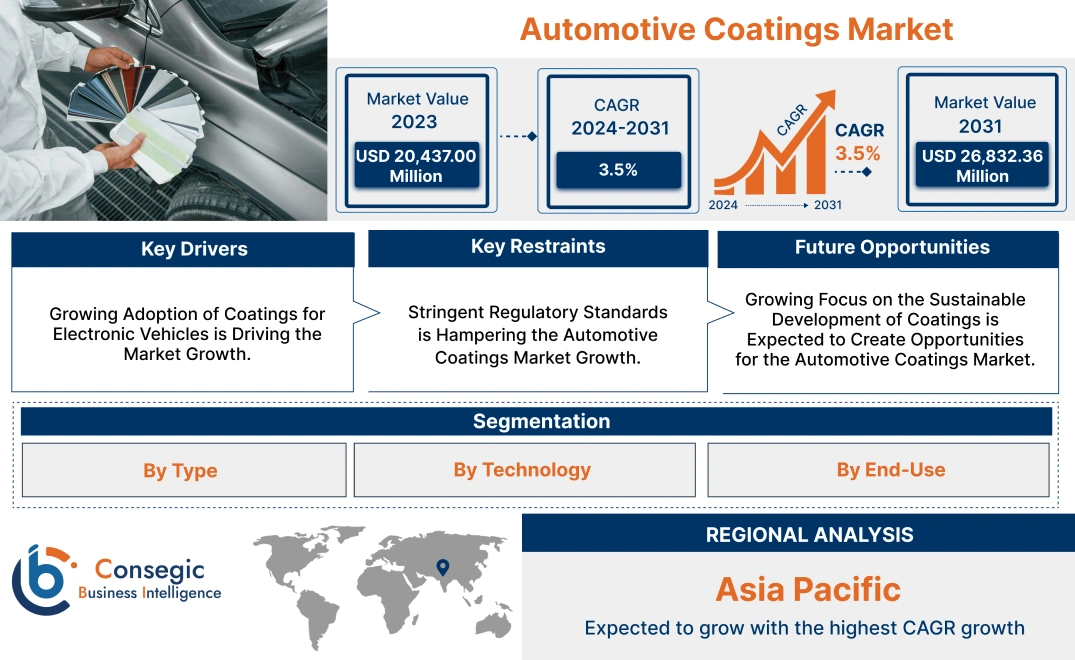Automotive Coatings Market Size:
Automotive Coatings Market size is growing with a CAGR of 3.5% during the forecast period (2024-2031), and the market is projected to be valued at USD 26,832.36 Million by 2031 from USD 20,437.00 Million in 2023.
Automotive Coatings Market Scope & Overview:
Automotive coatings are specialized materials applied to vehicle surfaces to protect them from corrosion and enhance their appearance. These coatings are formulated to withstand harsh conditions such as UV radiation, extreme temperatures, moisture, and chemical exposure. They also provide resistance to scratches. Beyond protection, they play a crucial role in defining the aesthetic appeal of a vehicle, offering a wide range of colors, finishes, and textures. The coatings are developed in water-based and solvent-based formulations using a wide range of resins such as polyurethane, epoxy, acrylic, alkyd, and polyester among others. They are applied using several technologies including liquid coating, powder coating, and UV-curable coatings among others.
Automotive Coatings Market Dynamics - (DRO) :
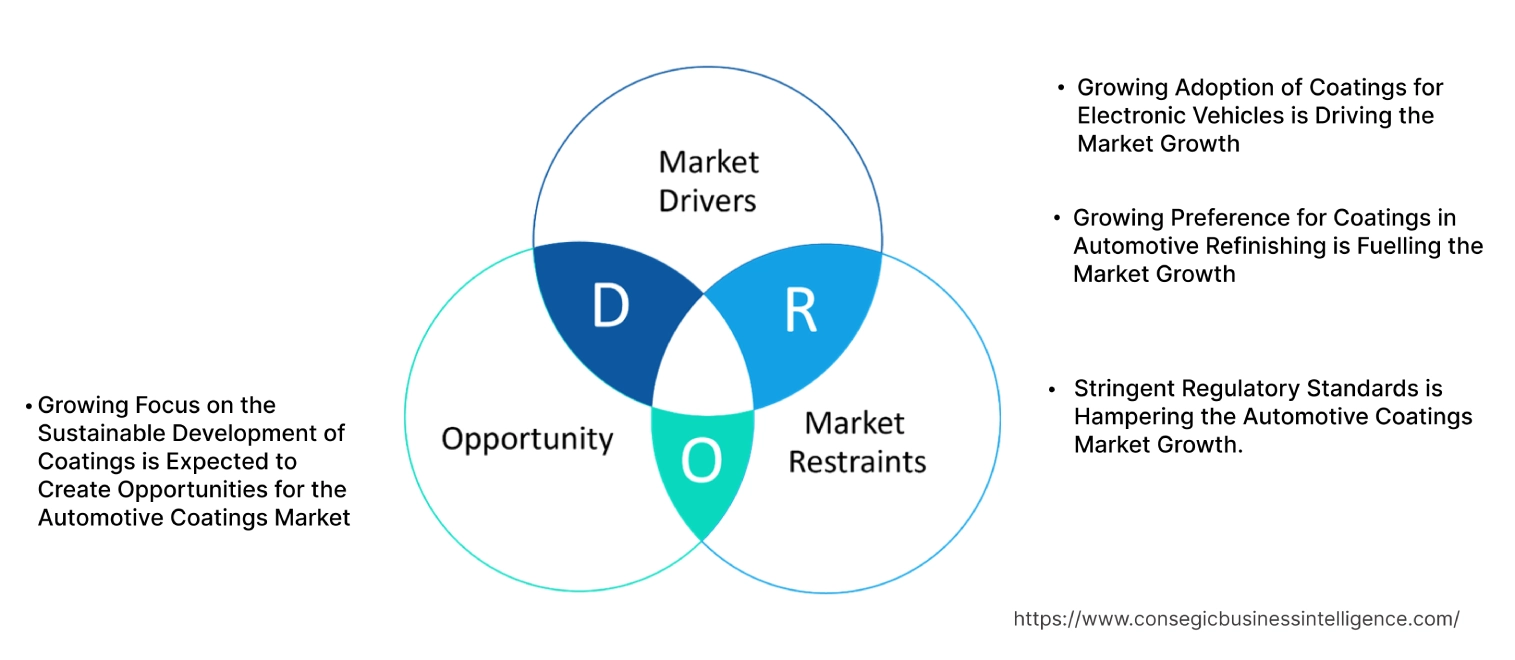
Key Drivers:
Growing Adoption of Coatings for Electronic Vehicles is Driving the Market Growth.
The automotive sector is undergoing a significant transformation, driven by the increasing adoption of electric vehicles (EVs). This shift towards electric mobility is directly impacting the market for coatings developed for automotive, as EVs require specialized coatings to meet their unique needs.
One of the prominent factors is the need for advanced coatings that protect EV batteries from corrosion, heat, and moisture. These batteries are a critical component of EVs, and their longevity and performance are essential for the vehicle's overall reliability. Coatings play a crucial role in safeguarding the battery pack, ensuring optimal performance, and extending its lifespan. Thus, there is a growing focus on the development of coatings specifically for electronic vehicles.
- For instance, in 2023, AkzoNobel, one of the leading manufacturers of paints and coatings, launched a dedicated range of Resicoat EV powder coatings. The range is specifically designed to help improve the safety and performance of EV components such as battery systems and electric motors. They have superior electrical insulating properties and enhanced thermal management to help protect the battery systems, motors, and electrical storage units.
The growing demand for EVs, coupled with the need for advanced coatings to protect key components, is driving significant innovation in the automotive coatings market growth.
Growing Preference for Coatings in Automotive Refinishing is Fuelling the Market Growth.
The development of coatings for automotive refinishing is a significant factor driving the trajectory of the automotive coating market. Automotive refinishing is the process of coating vehicles such as cars, motorcycles, and trucks to restore their original appearance or apply a new finish. This process is typically carried out in specialized facilities like auto body shops and paint shops.
The requirement for automotive refinishing is driven by several factors. The increasing number of vehicles on the road leads to a higher requirement for repair and refinishing services as vehicles age. Road accidents and the desire for aesthetic upgrades also contribute to the demand. Additionally, refinishing protects vehicles from corrosion, especially in harsh climates. This is creating the development of high-performance coatings specifically developed for automotive refinishing.
- For instance, in November 2023, PPG, one of the key players operating in the coatings market, introduced the PPG DP7000 Air-Dry Primer and a series of accompanying products for automotive refinishing markets in Europe, the Middle East, and Africa (EMEA). The PPG DP7000 primer is designed to boost efficiency and profitability in body shops by significantly reducing drying time compared to traditional air-dry technologies. This rapid-drying primer is compatible with PPG's ENVIROBASE High-Performance basecoats, DELTRON Progress UHS topcoat, and other PPG topcoat systems.
Overall, as per market analysis, the requirement for coatings in automotive refinishing is significantly contributing to the automotive coatings market expansion.
Key Restraints :
Stringent Regulatory Standards is Hampering the Automotive Coatings Market Growth.
Stringent regulatory standards imposed by government bodies worldwide pose significant constraints in the automotive coatings market. These regulations, designed to protect the environment and public health, increase production costs and slow down product development. The increasing focus on reducing the use of hazardous substances such as such as lead, mercury, and cadmium necessitates reformulation efforts, which become complex and time-consuming.
Additionally, the automotive sector is subject to stringent safety standards, including those related to fire resistance and corrosion protection. Coatings must meet these standards to ensure the safety and durability of vehicles. Compliance with these regulations increases the cost of product development and testing. These regulations also result in significant disruptions to traditional sector supply chains and loss of current raw materials uses. Moreover, evolving federal regulations accelerate annual compliance and operating costs throughout automotive sector supply chains, including the coatings industry. Thus, the impact of these stringent regulations on the automotive coatings market expansion is multifaceted.
Future Opportunities :
Growing Focus on the Sustainable Development of Coatings is Expected to Create Opportunities for the Automotive Coatings Market.
The automotive sector is increasingly prioritizing sustainability. Automakers are responding by adopting sustainable practices throughout the manufacturing process. Coatings manufacturers are developing solvent-free formulations that minimize environmental impact. These coatings offer excellent performance and durability while reducing emissions and energy consumption.
Another important aspect of sustainable coatings is the use of renewable and recycled materials. Incorporation of renewable raw materials into their formulations, allows coatings manufacturers to reduce their reliance on fossil fuels and minimize their carbon footprint. Additionally, the recycling of coatings waste helps to conserve resources and reduce waste disposal. Moreover, manufacturers are adopting the strategy of recycling waste to develop new coatings.
- For instance, in September 2024, BASF Coatings unveiled new product lines at Automechanika 2024, showcasing its commitment to sustainable innovation. Leveraging its ChemCycling technology, BASF developed a new generation of clearcoats that utilize recycled waste tires as a feedstock. These eco-friendly clearcoats, marketed under the Glasurit and R-M brands, offer rapid drying times, reducing energy consumption and enhancing production efficiency. BASF Coatings’ Glasurit AraClass A-C-24 Eco Balance and R-M Race Finish-R eSense clearcoats are the first automotive refinish products that utilize this technology. This innovative approach demonstrates BASF's dedication to the sustainable development of coatings for automotive applications.
Thus, as per analysis, as the automotive sector continues to evolve, the requirement for sustainable coatings is expected to grow while meeting the evolving needs of the automotive coatings market opportunities.
Automotive Coatings Market Segmental Analysis :
By Type:
Based on type, the market is categorized into polyurethane, epoxy, acrylic, alkyd, polyester, and others.
Trends in the Type:
- Development of coatings using hybrid resins.
- The development of customized vehicles creates the requirement for high-performance coating materials.
The epoxy segment accounted for the largest market share in 2023.
- Epoxy resin has become a key component in coatings developed for automotive applications due to its exceptional performance and versatility. Coatings developed using polyurethane offer a wide range of properties, including exceptional durability, flexibility, and resistance to abrasion, chemicals, and weathering.
- Epoxy coatings find applications such as topcoats, clearcoats, and primers. Topcoats provide the final, protective layer, while clearcoats enhance appearance and durability. Primers ensure proper adhesion to the substrate and provide corrosion protection.
- Moreover, the development of innovative epoxy coatings is driving the segment trajectory.
- For instance, in March 2023, Westlake Corporation AZURES product range at the European Coatings Show 2023. Westlake Epoxy’s Azures products are newly developed epoxy resins that are free of any SVHC (substances of very high concern) and CMR (carcinogenic, mutagenic, or toxic for reproduction) labeled substances. As such, they provide better sustainable alternatives to existing technologies used in coatings including those developed for automotive applications.
- These advancements, coupled with the increasing requirement for durable and aesthetically pleasing automotive finishes, create the need for epoxy for coatings in automotive applications.
The other segment is expected to grow at the fastest CAGR over the forecast period.
- The other segment includes ceramic coatings, hybrid coatings, and others.
- Ceramic coatings, also known as glass coatings, have emerged as a popular choice for protecting automotive surfaces. It contains silicon dioxide (SiO2) as a primary component. Ceramic coatings enhance the vehicle's appearance by increasing its gloss and shine, while also making it easier to clean and maintain. Additionally, their hydrophobic properties make cleaning easier and prevent water spots, while UV protection safeguards the paint from fading and discoloration.
- Hybrid resin coatings are a new class of coatings that combine the properties of two or more different types of resins. This combination allows for the creation of coatings with superior performance characteristics compared to traditional single-resin coatings. Acrylic-urethane hybrid coatings are widely used in automotive coatings to provide a high-quality, long-lasting finish.
- The increasing preference for premium finishes, coupled with advancements in coating technologies, is driving the requirement for ceramic and hybrid resin coatings. Additionally, growing consumer demand for high-performance coatings in the automotive sector is a prominent factor driving segment trajectory.
By Technology:
Based on technology, the market is categorized into liquid coating, powder coating, UV curable coating, and others.
Trends in Technology:
- The increasing focus on water-based coatings to reduce environmental impacts.
- Rising popularity of powder coating due to eco-friendliness and high efficiency:
The liquid coatings segment accounted for the largest market share of 29.72% in the year 2023.
- Liquid coatings are the most traditional and widely used technology in the automotive sector. They are primarily developed as waterborne and solvent-borne coatings.
- They offer numerous advantages, including versatility, customizability, durability, and aesthetic appeal. Liquid coatings allow application to a variety of substrates and are customizable with a wide range of colors, finishes, and textures. They provide excellent protection against environmental factors such as UV radiation, moisture, and corrosion.
- Liquid coatings typically consist of basecoats, clearcoats, and primers. Basecoats provide color and metallic effects to the vehicle's surface, while clearcoats enhance the overall appearance and provide a protective layer. Primers are applied to improve adhesion and corrosion resistance.
- Additionally, ongoing research and development are leading to innovative liquid coatings with improved performance, such as anti-microbial coatings and anti-fingerprint coatings.
- Thus, as the automotive sector continues to evolve, liquid coatings remain a crucial technology, and advancements in formulation and application techniques are driving their ongoing evolution.
The powder coating segment is expected to grow at the fastest CAGR over the forecast period.
- Powder coatings have emerged as a popular and environmentally friendly coating process in the automotive sector. Powder coating involves applying a dry powder to a surface, which is then cured under heat to form a durable, high-quality finish.
- This process offers several advantages, including excellent durability, a consistent and uniform finish, and environmental friendliness.
- In the automotive sector, powder coating is widely used for various components, such as wheels, chassis parts, engine blocks, brake calipers, interior components, and even certain exterior components.
- Additionally, the development of powder coating tailored for specific vehicle types is expected to create segment trajectories.
- For instance, in 2023, AkzoNobel, one of the leading manufacturers of paints and coatings, announced the launch of a new powder coating called Interpon A3000 for two-wheelers. Interpon A3000 is designed to protect and enhance the body parts, wheels, and trim of any two-wheeled vehicle.
- Thus,powder coating is a promising technology for the automotive coating industry, offering a sustainable and high-quality solution for various components.
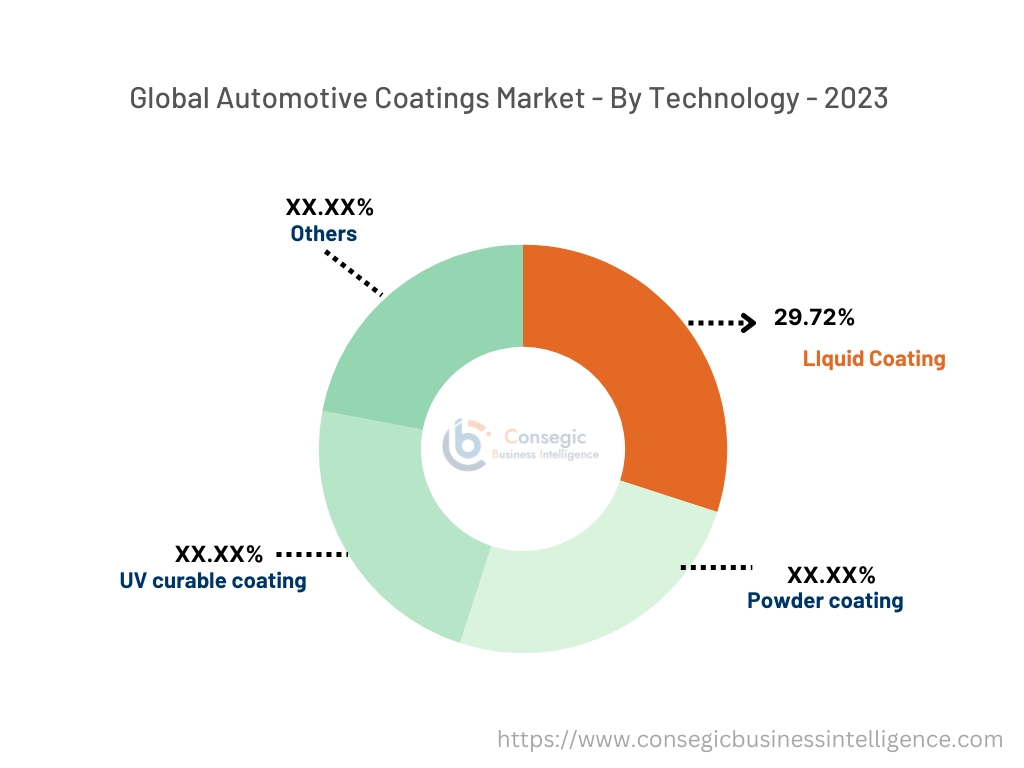
By End Use:
Based on end use, the market is categorized into OEM and automotive aftermarket.
Trends in the End Use:
- Emphasis on lightweight coatings to reduce vehicle weight.
- Adoption of quick-drying and fast-curing coatings to reduce repair times and improve efficiency.
The OEM segment accounted for the largest market share in the year 2023.
- Original equipment manufacturers (OEM) are the primary users of coatings specially designed for automotive applications. OEM coatings are applied to new vehicles during the manufacturing process. These coatings serve multiple purposes, including corrosion resistance, UV protection, and enhancing the overall appearance of the vehicle.
- The adoption of coatings in the automotive OEM is driven by several factors. Rising vehicle production necessitates increased coating usage for protection and aesthetic enhancement.
- For instance, according to the data provided by TD Economics in April 2024, automotive production activity has grown significantly with 15.6 million vehicles produced in North America in 2023, a 9.6% gain relative to 2022. U.S. light vehicles sales in turn grew 12.7% in 2023. This analysis creates a higher requirement for coatings in OEM.
- Consumer preference for durable vehicles is driving a requirement for advanced coatings with enhanced properties. Additionally, the automotive sector’s focus on lightweight to improve fuel efficiency benefits from lightweight coating solutions. The combination of these factors is significantly driving the requirement for coatings in the automotive OEM fuelling the overall automotive coatings market trend.
The automotive aftermarket segment is expected to grow at the fastest CAGR over the forecast period.
- Automotive coatings play a crucial role in the aftermarket, restoring and enhancing the appearance of vehicles. Vehicles require regular maintenance and repainting to ensure their longevity and appearance.
- In the aftermarket, coatings are used to repair damage caused by accidents, such as dents and scratches. They also enable customization by allowing for color changes, unique finishes, and the application of protective layers like vinyl wraps.
- Additionally, coatings are crucial for restoring classic and vintage vehicles to their original condition. By addressing these various needs, these coatings help to maintain the value and appeal of vehicles throughout their lifespan.
- Thus, based on the automotive coatings market analysis, these coatings are widely used in aftermarket maintaining vehicle appearance and value. They address various needs, from accident repairs to customization and restoration, ensuring vehicles remain aesthetically pleasing and functional throughout their lifespan.
Regional Analysis:
The regional segment includes North America, Europe, Asia Pacific, the Middle East and Africa, and Latin America.
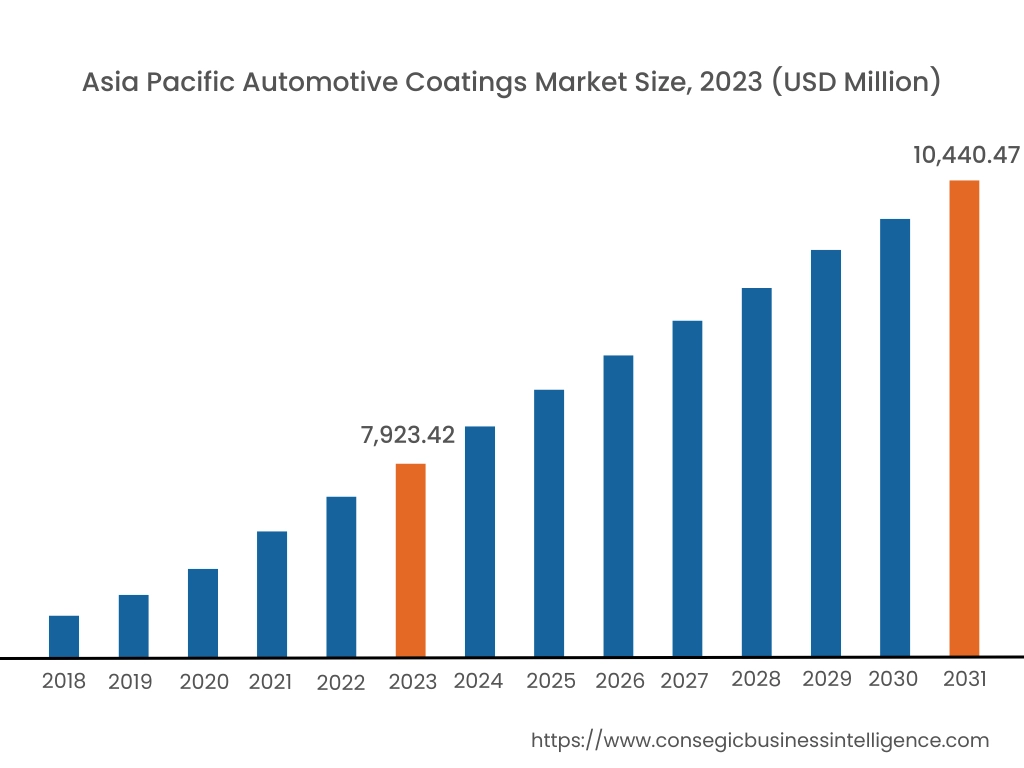
In 2023, Aisa Pacific accounted for the highest market share at 38.77% and was valued at USD 7,923.42 Million and is expected to reach USD 10,440.47 Million in 2031. In Asia Pacific, China accounted for the highest market share of 23.15% during the base year of 2023.
Asia Pacific dominates the global automotive coatings market, primarily due to the rapidly accelerating automotive manufacturing in countries such as China, India, and South Korea. Governments in the region are promoting infrastructure development and automotive manufacturing, further boosting the automotive coatings industry. The growing vehicle production creates a higher requirement for coatings.
- For instance, according to the China Association of Automobile Manufacturers, in 2023, China's car output exceeded 30.16 million units, with 11.6% year-on-year growth.
Additionally, countries across the region have witnessed rapid industrialization, leading to increased requirements for automobiles, both for personal and commercial use. The increasing need for affordable vehicles, coupled with rising disposable incomes, is fueling the automotive coatings market. Additionally, the region's focus on lightweight materials and fuel-efficient vehicles is driving the requirement for specialized coatings. Moreover, the increasing emphasis on electric vehicles is creating the requirement for specialized coatings that protect batteries, electric motors, and other components. The combination of the aforementioned factors and trends is driving a substantial trajectory in the Asia Pacific automotive coatings market share.
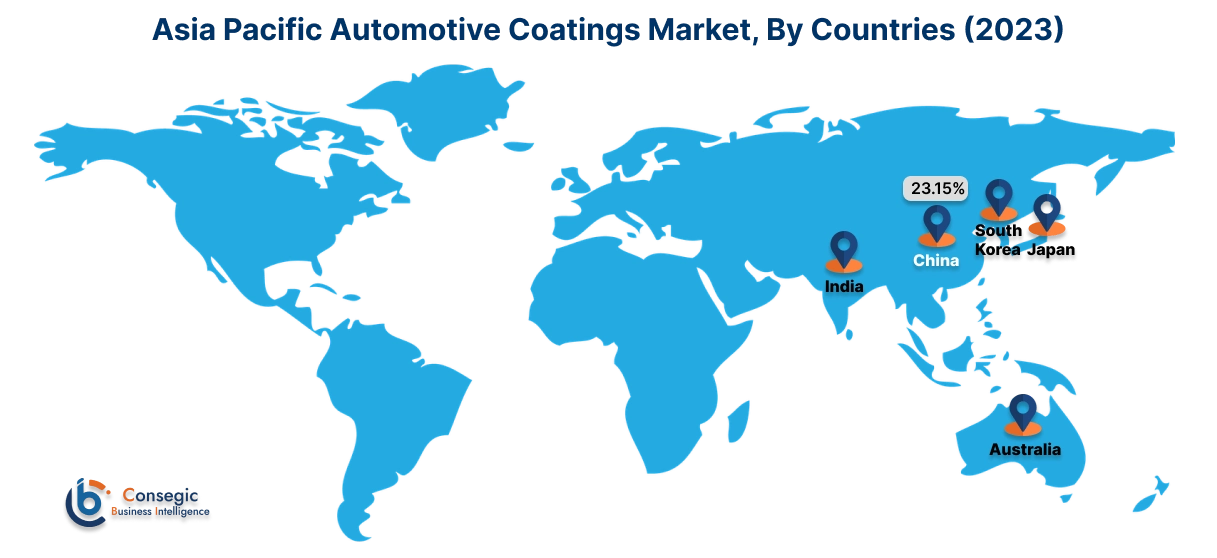
North America is experiencing the fastest growth with a CAGR of 4.2% over the forecast period. The automotive coatings market trend across the region is attributed to factors such as the presence of major automotive manufacturers and a strong emphasis on vehicle aesthetics and durability. Key factors driving the market include increasing vehicle production, stringent emission regulations, and the rising demand for luxury and high-performance vehicles. The region's focus on advanced technologies, such as waterborne and solvent-borne coatings, is further propelling the market trajectory. Refinish coatings are also a significant contributor to the North American market. This segment is driven by the need to repair and restore damaged vehicles, and the requirement for customized finishes.
Europe presents a significant contribution to the automotive coatings market analysis. The European automotive sector market is mature, creating constant requirements for coating solutions. Additionally, factors including stringent environmental regulations, increasing focus on fuel efficiency, and the rising requirement for premium and luxury vehicles are driving the automotive coating market across the region. European consumers are increasingly environmentally conscious, driving requirements for sustainable products. Automotive manufacturers are responding by incorporating sustainable practices into their production processes, including the use of eco-friendly coatings. European manufacturers and suppliers are at the forefront of technological advancements in coatings used in automotive further driving the marker trajectory across the region.
The Middle East and Africa (MEA) region is witnessing notable automotive coatings market demand characterized by significant potential. The MEA regions are experiencing rapid industrialization and urbanization, driving significant rise in the automotive sector. The automotive sector in the Middle East and Africa is expanding, with increased production of both passenger cars and commercial vehicles. This growth is driving the requirement for a wide range of coatings, including basecoats, clearcoats, and specialty coatings. Additionally, as disposable incomes increase, particularly in the Gulf Cooperation Council (GCC) countries, there is a surge in demand for luxury and premium vehicles. This trend is driving the requirement for high-quality, aesthetically appealing coatings further creating automotive coatings market opportunities in the MEA.
Latin America is an emerging region in the automotive coatings market share, with significant potential for innovation. The Latin American automotive sector is experiencing a significant trajectory, driven by increasing disposable incomes, government initiatives, and rising requirements for personal mobility. This trend has led to a corresponding increase in the need for coatings for automobiles. Additionally, rapid urbanization and infrastructure development are driving the need for efficient transportation solutions. This includes the rise in public transportation systems. Commercial vehicles boast higher requirements for coatings. This analysis presents a substantial opportunity for automotive coating manufacturers and suppliers to capitalize on this burgeoning market and contribute to the region's automotive coatings market demand.
Top Key Players & Market Share Insights:
The Automotive Coatings market is highly competitive with major players providing precise products to the national and international markets. Key players are adopting several strategies in research and development (R&D) and product innovation to hold a strong position in the global Automotive Coatings market. Key players in the Automotive Coatings industry include-
- AkzoNobel (Netherlands)
- Birla Carbon (India)
- The Sherwin-Williams Company (U.S.)
- Jotun (Norway)
- Beckers Group (Sweden)
- PPG Industries, Inc. (U.S.)
- BASF (Germany)
- Axalta (U.S.)
- Kansai Paint Co., Ltd. (Japan)
- Nippon Paint Holdings Co., Ltd. (Japan)
Recent Industry Developments :
Product Launch:
- In April 2024, BASF’s coatings division announced the new line of clearcoats and undercoats aimed at the auto body shop market. The coatings include rapid UV-A and air-drying direct-to-metal technology, the company said.
- In January 2023, AkzoNobel, announced the launch of Resicoat EV powder coatings. The range is specifically designed to help improve the safety and performance of EV components such as battery systems and electric motors. They have superior electrical insulating properties and enhanced thermal management to help protect the battery systems, motors, and electrical storage units.
Automotive Coatings Market Report Insights :
| Report Attributes | Report Details |
| Study Timeline | 2018-2031 |
| Market Size in 2031 | USD 10,668.57 Million |
| CAGR (2024-2031) | 7.1% |
| By Type |
|
| By Technology |
|
| By End Use |
|
| By Region |
|
| Key Players |
|
| North America | U.S. Canada Mexico |
| Europe | U.K. Germany France Spain Italy Russia Benelux Rest of Europe |
| APAC | China South Korea Japan India Australia ASEAN Rest of Asia-Pacific |
| Middle East and Africa | GCC Turkey South Africa Rest of MEA |
| LATAM | Brazil Argentina Chile Rest of LATAM |
| Report Coverage |
|
Key Questions Answered in the Report
How big is the Automotive Coatings market? +
In 2023, the Automotive Coatings market is USD 20,437.00 Million.
Which is the fastest-growing region in the Automotive Coatings market? +
North America is the fastest-growing region in the Automotive Coatings market.
What specific segmentation details are covered in the Automotive Coatings market? +
Type, Technology, and End-use segmentation details are covered in the Automotive Coatings market.
Who are the major players in the Automotive Coatings market? +
AkzoNobel (Netherlands), Birla Carbon (India), and The Sherwin-Williams Company (U.S.) are some of the major players in the market.
